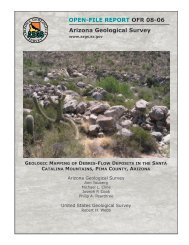geothermal resource potential of the safford-san simon basin, arizona
geothermal resource potential of the safford-san simon basin, arizona
geothermal resource potential of the safford-san simon basin, arizona
Create successful ePaper yourself
Turn your PDF publications into a flip-book with our unique Google optimized e-Paper software.
Whitlock Mountains Area<br />
In 1927 and 1928 <strong>the</strong> Pinal Oil Company Whitlock Oil #1 State was unsuccessfully<br />
drilled for oil in D-10-28-36AD. However, <strong>the</strong> hole encountered a<br />
strong artesian flow <strong>of</strong> <strong>the</strong>rmal water (4l o C)<br />
from conglomerate below 440.4 m<br />
to total depth at 586.7m.<br />
Today artesian flow <strong>of</strong> <strong>the</strong>rmal water from<br />
this well continues.<br />
An additional oil and gas test, <strong>the</strong> Bear Springs Oil<br />
#1 Allen, formerly discharged "lukewarm" water (Knechtel, 1938). This well,<br />
drilled to 473.9m, has since been destroyed.<br />
The Badger Den well, D-10<br />
29-20AC, discharged 34.l o C water in <strong>the</strong> late 1970s (Swanberg and o<strong>the</strong>rs, 1977).<br />
Presently, this well is inoperative due to pump removal.<br />
These <strong>the</strong>rmal wells at <strong>the</strong> sou<strong>the</strong>rn terminous <strong>of</strong> <strong>the</strong> Whitlock Mountains<br />
indicate a significant low-temperature «100 o e) <strong>geo<strong>the</strong>rmal</strong> <strong>resource</strong> suitable<br />
for direct-heat use in agricultural applications.<br />
Total dissolved solids (TDS)<br />
between 1,100 and 700 milligrams per liter (mg/l) are reported for water discharging<br />
from <strong>the</strong>rmal wells in <strong>the</strong> area (Table 2).<br />
These <strong>the</strong>rmal waters are<br />
sodium chloride-sulfate composition and <strong>the</strong>y contain fluoride concentrations<br />
exceeding five mg/1 (see Table 2) •<br />
Siltstone and clay to 440m provide a confining cap rock over conglomerate<br />
aquifers in <strong>the</strong> vicinity <strong>of</strong> <strong>the</strong> Whitlock #1 well.<br />
Fractured Tertiary<br />
volcanic rock may host <strong>the</strong> <strong>the</strong>rmal aquifer for <strong>the</strong> Badger Den well.<br />
Chemical geo<strong>the</strong>rmometry, using <strong>the</strong> Na-K-Ca geo<strong>the</strong>rmometer, predicts 104<br />
o<br />
to 132 C deep subsurface temperature.<br />
Caution is advised, however, in using<br />
<strong>the</strong>se results because fur<strong>the</strong>r geochemical and geophysical studies are required<br />
to confirm a deep intermediate-temperature (100-150 o C) <strong>resource</strong>. Additional<br />
wells 457 to 610m depth are likely to encounter 40 to 50 0 C water and<br />
may produce artesian flow exceeding 200 gallons per minute.<br />
88

















